|
GEOMEDIA
Check out the latest On the Web links, your connection to earth science friendly Web sites. The popular Geomedia feature is now available by topic.
Movies: Wall-E: Save the Robot, Save the World
Books: Africa Atlas: Worth a Thousand Words
TV: When NASA Left Earth
Books: The Great Warming: The Climatic Rise and Fall of Civilizations
Save the Robot, Save the World
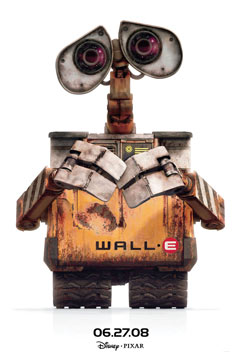 Courtesy of Disney/Pixar |
Truth be told, I’m usually a cartoon humbug. But from the opening frame of this summer’s Disney/Pixar movie Wall-E — a view of Earth from space, but not our familiar blue and green home, instead the planet is brown and gray and orbited by a thick ring of galactic trash — I realized that this movie had a message above and beyond the usual gooey, goofy animated fare.
It’s the year 2775 and Earth has been abandoned by everyone and everything except for a lone robot and a swarm of immortal cockroaches. The iconic New York City skyline is dwarfed by skyscrapers of trash and Wall-E, short for Waste Allocation Load Lifter – Earth-Class, is the architect. He spends his days scooping waste into his trash-compactor stomach, burping out cubes and stacking them into towering piles.
Humans may have been heinous waste-mongers (encouraged by the ubiquitously advertised “Buy N Large” bulk empire), but not Wall-E. Every morning the oddly endearing robot recharges using solar power (the familiar Mac power-on chime when he’s fully charged got a lot of laughs during my screening) and he’s also a diligent recycler, reusing tire treads and parts from other defunct robots when he needs repairs. In this manner, Wall-E has lived sustainably while cleaning up our mess for more than 700 years.
All that time alone has made Wall-E sentimental. As he sifts through our trash he finds treasures — a rubber ducky, an iPod, bubble wrap, a Rubik’s cube — and takes them back to his Christmas-light-lit lair. Wall-E’s nostalgia sparked my own, not for the things he finds but for the healthy blue sky and growing green Earth missing from Wall-E’s bleak world.
But one day everything changes. Wall-E is joined by a visitor from space, a sleek robot named Eve. Wall-E falls instantly in robot-love and when Eve departs on her spaceship, he hitches a ride. After the rocket punches through Earth’s orbiting trash into space, it flies by a montage of space icons — sputnik, the golden LEM and Neil Armstrong’s unwaving lunar flag — on its way to the Axiom, the colossal spaceship home to the even more colossal human race. Thanks to hover chairs — “No need to walk!” — and liquid meals like cupcake-in-a-cup, this version of mankind has become grotesquely obese and mentally more robotic than the heroic Wall-E.
Wall-E’s nonstop adventure and superb Charlie Chaplin-style physical comedy (there’s almost no dialogue) will certainly appeal to kids, but the flick has a lot for adults too. Wall-E’s commentary on our waste woes and the cultural quirks that contribute to our environmental problems is razor-sharp: In an old clip from 2110, the world’s head waste-monger dismisses the need to become more sustainable, stubbornly declaring, “We must stay the course!” In fact, Wall-E is so sharp that by the end, I was relieved to be watching a cartoon where a robot’s love and eternal optimism can save Earth from a bleak future that is all too real.
Wall-E opened in theaters June 27; the DVD release has not been scheduled yet.
To research creating the movie’s characters, Wall-E’s animation team studied robots and rovers at NASA. Disney/Pixar and NASA have also teamed up as educational partners to promote space exploration to Wall-E’s younger fans. Soon the robot Wall-E will appear in classrooms everywhere to teach kids about outer space as well as more earthly environmental issues. Visit www.nasa.gov and NASA Kids’ Club at www.nasa.gov/audience/forkids/kidsclub/flash/index.html to see Wall-E in action. |
Links:
NASA
NASA Kids’ Club
Save the Robot, Save the World, Geotimes online, Web Extra, June 27, 2008
Worth a Thousand Words
The years have not been kind to Africa’s wilderness. Over the past three decades, forests have disappeared, lakes have shrunk and glaciers have melted. But because such changes happen gradually, they’re often overlooked. A new book released in June by the United Nations Environment Programme, however, aims to drive home the message that Africa’s landscape is drastically changing.
Africa: Atlas of Our Changing Environment presents 316 stunning satellite images spanning 36 years. These “before” and “after” shots highlight how development, population growth, climate change and conflicts have changed the face of Africa. The picture that emerges isn’t pretty: Africa is losing 40,000 square kilometers of forest every year, 60 percent of its farmlands are degraded and 300 million people face water shortages. An influx of refugees has damaged the delicate ecosystems of the Jebel Marra foothills of western Sudan. In Rwanda, much of the Gishwati Forest Reserve has been harvested for charcoal, timber, medicine and food. Over the past 35 years, Lake Chad — which is bordered by eight African countries and supports roughly 20 million people — has shrunk to just a tenth of its former size.
Still, success stories do exist. In Tunisia, for example, grasslands have rebounded dramatically inside Sidi Toui National Park, which is protected from grazing cattle.
The entire atlas is available for download at www.unep.org/dewa/africa/AfricaAtlas.
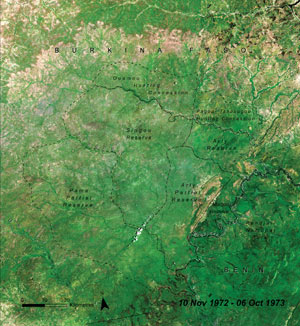 |
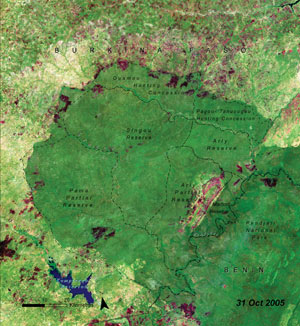 Both maps courtesy of the United Nations Environment Programme |
| Satellite images of “W” National Park in Burkina Faso. In the early 1970s (left), the park was indistinguishable from the surrounding forest. By 2005 (right), however, the park’s borders were clearly visible. The scattered dark purple patches are burn scars. | |
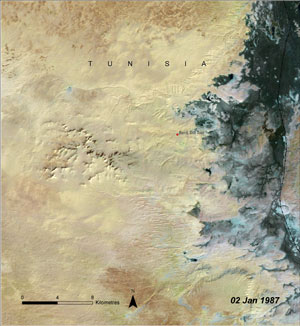 |
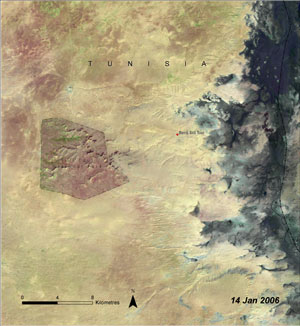 Both maps courtesy of the United Nations Environment Programme |
| Agriculture and overgrazing left this grassland in northern Tunisia barren in 1987 (left). In 1993, Sidi Toui National Park was established and vegetation began to regenerate. By 2006 (right), the park borders were clearly visible. The park is now home to a small population of critically endangered Scimitar-horned oryx. | |
Links:
AFRICA Atlas of Our Changing Environment
When NASA Left Earth
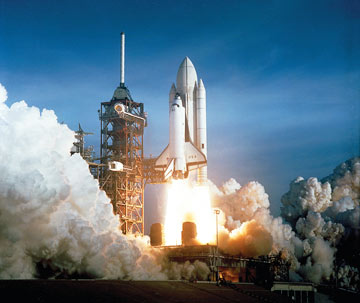 NASA |
| “When We Left Earth” chronicles NASA’s exploration milestones, such as when astronauts John Young and Robert Crippen flew the first space shuttle into orbit in April 1981. |
Space travel may seem routine today, but it hasn’t always been that way. That’s one message of the Discovery Channel’s recent documentary, “When We Left Earth: The NASA Missions,” which chronicles NASA’s 50 years of manned space exploration.
The documentary was born last year, when NASA gave the Discovery Channel access to its film vault. After screening 500 hours of footage, the Discovery Channel transferred more than 150 hours of film to high definition and selected six hours, including rarely seen recordings, for its six-part miniseries, “When We Left Earth.” The miniseries debuted in June and is available — along with four extra hours of footage — on DVD and Blue-ray Disc at http://shopping.discovery.com.
“When We Left Earth” weaves its images with interviews from astronauts, flight directors and astronaut spouses to tell its tale. The usual players — John Glenn, Buzz Aldrin and Neil Armstrong — are all there. But some of the documentary’s most captivating, entertaining perspectives come from astronauts who may not be household names, such as John Young, a prolific, quirky astronaut who flew the first manned Gemini spacecraft, walked on the moon and piloted the space shuttle’s first trip to space. The on-the-ground viewpoint of retired flight director Gene Kranz, who sat in Mission Control for more than 30 years, serves as a source of continuity as the series progresses from the early days of manned space exploration with the Mercury and Gemini projects to the Apollo moon missions to the current age of the space shuttle and the International Space Station.
The documentary also reminds viewers that NASA has provided the world with some of the most iconic images of the 20th century. Watching Neil Armstrong touch the moon’s surface is still amazing and seeing the Challenger explode is still shocking. Some of the documentary’s best footage is less dramatic and gives viewers a new perspective on space — a cockpit view of John Glenn as he talks with Mission Control during his orbit around Earth or liftoff from the space shuttle’s perspective.
Space buffs will likely enjoy this touched-up look at a familiar subject, but “When We Left Earth” may be most appreciated by younger viewers who are not old enough to remember NASA’s exploration milestones. However, the film’s footage clearly drives the documentary’s story. Some viewers may yearn for more details and development of the cultural and historical context in which NASA’s missions emerged. For example, the documentary dives right into the Mercury project with little explanation of why the United States formed NASA in the first place.
But in an age when remotely operated rovers beam down images of the Martian landscape to Earth and astronauts live in space for months at a time, “When We Left Earth” reminds viewers of the reality of space exploration: Although space travel seems routine, traveling through space is anything but ordinary.
Links:
Discovery Channel Store
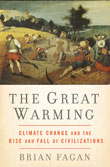 |
The Great Warming: Climate Change and the Rise and Fall of Civilizations |
In the discussion about climate change, melting ice sheets, sea-level rise and extreme weather take center stage. But archaeologist Brian Fagan says that our preoccupation with these dramatic events has led us to ignore a much greater threat: drought. We need only look at history to see the enormous power droughts have over the fate of humans, he says. In his new book, The Great Warming: Climate Change and the Rise and Fall of Civilizations, Fagan takes readers on a journey through the Medieval Warm Period, a time of unusually warm weather between about A.D. 800 and 1300. Linking historical events with climate clues that scientists gathered from sea and lakebeds, ice cores and tree rings, Fagan shows us how drought contributed to the struggle and collapse of ancient societies, such as the Maya civilization.
Fagan devotes almost the entire book to exploring what happened at various parts of the planet during the Medieval Warm Period, but the last chapter delves into future predictions of drought conditions. His narrative style makes The Great Warming an interesting read and the book provides the lay reader with an engaging account of not only what has happened, but also what may lie in store for us in the future.
Fagan spoke with freelance writer Nicole Branan about the Medieval Warm Period and the lessons it holds for today’s societies.
 Courtesy of Leslie Newhart |
NB: When you set out to research this book, did you expect to see that drought played such an important role in the fate of ancient civilizations?
BF: No, I didn’t. I originally thought the book would focus on Europe and I had images of apple-cheeked peasants enjoying bountiful harvests. And indeed, the Medieval Warm Period was pretty good for Europe. But when I started to look globally, I was astounded to find that there were widespread droughts, all of which appeared to be linked to this period of warming.
NB: Are we more vulnerable to drought today than human societies were a millennium ago?
BF: Absolutely, simply because there are many more of us. A thousand years ago, people rolled with the climatic punches and, in the face of drought, moved to the few areas with permanent water that there were. Today, if you look at Phoenix, Tucson or Los Angeles, for example, you have these enormous urban populations — and clearly, you can’t move [them].
NB: But our scientific knowledge and our water treatment technologies are much more advanced today than they were during the Medieval Warm Period. Isn’t that going to make a difference?
BF: Yes, I imagine it will. And one of the things that lies in the future is a massive use of recycled water, for example. But we also have to make major adjustments in the way we live. One example that seems rather silly but actually isn’t is the enormous amount of water consumed by golf courses. The question is, ”Is somebody going to develop a way of playing golf so that you don’t need these luxurious greens and fairways that you need now?” Another example is the amazing number of lawns in semi-arid regions, for example here in Santa Barbara, Calif. And every time you see a new house they put in all these water-hungry plants rather than native vegetation. We are faced with the challenge of learning how to live appropriately in an arid and semi-arid environment. There is a great deal we can do by adjusting, but even so, the problem is catastrophically serious.
NB: In coming decades, who is going to get hit hardest by drought?
BF: That’s hard to answer with any precision but it looks to me as if the areas that are most vulnerable are those that are semi-arid and arid. An obvious example is the American West, which suffered truly epochal droughts a thousand years ago, some of which lasted up to 140 years. Other areas are sub-Saharan Africa and Australia, but the list goes on and on.
NB: What do we need to do in order to avoid a catastrophe?
BF: A lot of it may be re-ordering the way we use water. We seriously need to go into the water allocation business, and obviously down the line there have to be some very severe restrictions on the promiscuous use of water. These are all obvious things but they all take political will, and above all, they take long-term thinking that transcends an election.
NB: Is there anything else you would like to add?
BF: I am an archeologist and my interest in climate change is in the human impact of it. I think if we try to understand the human impact of climate change without looking, at least superficially, at the past, we are being stupid because we have some lessons to learn from it. One big lesson is that humans are wise and that they will rise to the challenge. We will find solutions, but they have to be long-term solutions and they have to be very carefully crafted. At the moment, very few people are thinking that way.

 Subscribe
Subscribe


